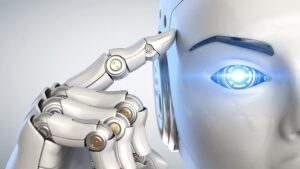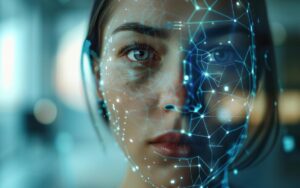Artificial intelligence and machine learning are recognized as two of the hottest technologies today, with the potential to profoundly affect the online business world and the individual consumer. The field of AI has supplied a constant stream of innovations, but which AI technologies are set to be the most influential in the near future?
This article deals with the best AI tech today and devotes time to explaining artificial intelligence, how it works, available AI, a short history, pros and cons, and other practical AI concepts. We wrap things up with an opportunity to learn more about artificial intelligence and how to enter the AI field.
We begin our journey with a brief definition of artificial intelligence technology.
What is Artificial Intelligence? A Brief Reminder
Artificial intelligence is machines’ simulation of human intelligence, with a strong emphasis on computer systems. It’s a set of technologies that allow computers to perform many advanced functions otherwise done by people, including the ability to see, understand, and translate written and spoken language, make recommendations, analyze data, and much more.
AI tech is typically broken down into four categories. Let’s check them out.
Also Read: How To Start a Career in AI and Machine Learning?
The Four Types of Artificial Intelligence Technology
At a high level, AI technologies can be broken in to four distinct categories.
Reactive machines
These AI systems are task-specific and don’t have a memory. For example, deep Blue, the IBM-created chess program that beat Garry Kasparov in the 1990s, can identify the pieces on the chessboard and generate predictions, but it has no memory; thus, it can’t use past experiences to influence future actions.
Limited memory
This artificial intelligence technology has memory, so unlike reactive machines, it can use past experiences to influence future decisions. Self-driving cars fall into this category.
Theory of mind
The term “theory of mind” comes from the field of psychology. When used in an AI context, it means the AI system has the social intelligence to understand emotions. This type of AI could infer human intentions and predict behavior, a synthetic form of empathy necessary for AI systems to integrate smoothly with their human counterparts.
Self-awareness
We’re now venturing into science fiction territory. This category describes AI systems with a sense of self, giving them consciousness and self-awareness. Unfortunately, this type of AI doesn’t exist (yet!).
Now let’s see how AI technologies work.
How Does Artificial Intelligence Work?
Artificial intelligence technology typically works by consuming vast quantities of labeled training data, analyzing the data searching for patterns and correlations, then using these results to make predictions about future conditions and actions. Thus, a chatbot fed excerpts of text chats can learn to generate lifelike customer exchanges. Alternatively, an image recognition tool can review many image examples and then use this data to identify and describe objects in pictures.
Artificial intelligence programming emphasizes three cognitive skills: learning, reasoning, and self-correction. In addition, these programs are designed to run without human interaction.
- Learning processes. This aspect focuses on gathering data and creating rules for turning the data into actionable information. These rules, better known as algorithms, supply computing devices with step-by-step instructions for completing a given task.
- Reasoning processes. Often, an artificial intelligence program has many algorithms to choose from. Therefore, this aspect focuses on selecting the correct algorithm to reach the desired result.
- Self-correction processes. This aspect is designed to continually fine-tune algorithms, correcting errors and ensuring that the program provides the most accurate results possible.
So where does AI tech come from? Let’s take a journey into the past.
Also Read: What Machine Learning Skills Are Companies Looking For?
A Brief History of Artificial Intelligence
We could devote an entire article (or series) just to the history of artificial intelligence. Instead, let’s do a quick overview of AI tech.
- 1836. Augusta Ada Byron, Countess of Lovelace, and Cambridge University mathematician Charles Babbage invent the first concepts and designs that make programmable machines possible.
- The 1940s. Princeton mathematician John Von Neumann creates the architecture for the stored-program computer, including the concept of storing a computer program and the data it processes in the computer’s memory. Also, during this decade, Warren McCulloch and Walter Pitts laid the foundation for neural networks.
- The 1950s. Alan Turing, British mathematician and World War II code-breaker, develops the Turing Test, focusing on a computer’s ability to make interrogators think its answer comes from a human.
- 1956. This year is recognized as the start of the modern field of artificial intelligence at the Defense Advanced Research Projects Agency (DARPA) conference held at Dartmouth College.
- The 1950s and 1960s. Newell and Simon published the General Problem Solver (GPS) algorithm, which, although falling short of solving complex problems, laid the foundations for developing sophisticated cognitive architectures. Next, McCarthy developed Lisp, an AI programming language still used today. Finally, in the mid-1960s, MIT Professor Joseph Weizenbaum created ELIZA, an early natural language processing program that made today’s chatbots possible.
- The 1970s and 1980s. Governments and corporations back away from supporting AI research, which stalled AI research.
- 1990s through the 2010s. Thanks to a data explosion and computational power increases, AI research makes a comeback in the late 1990s and is still going on. Here we see breakthroughs in computer vision, natural language processing, robotics, deep learning, machine learning, and more.
- 1997. IBM’s Deep Blue becomes the first computer program to beat a world chess champion by defeating Russian chess grandmaster Garry Kasparov.
- 2011. IBM’s Watson defeats two former champions on the game show Jeopardy.
- Today. New AI technology advances arise regularly. For example, AI drives cars, diagnoses diseases, creates realistic chatbots, etc.
Why is Artificial Intelligence Important?
Artificial intelligence technology can handle repetitive tasks better than humans, working faster and with virtually no errors. As a result, businesses can run more efficiently, which opens up more opportunities for companies to compete, as well as give professionals the freedom to pursue the more complex and rewarding aspects of IT work, freeing them from the dull redundant tasks better left to an AI-enhanced computer.
Also Read: How Does AI Work? A Beginner’s Guide
The Advantages and Disadvantages of Artificial Intelligence
Here’s a breakdown of the positives and negatives of AI technologies.
Advantages of AI Tech
- AI is good at detail-oriented jobs
- It reduces the time needed to perform data-heavy tasks
- It delivers consistent results
- AI-powered agents are always available; they don’t need breaks
Disadvantages of AI Tech
- AI is expensive
- It requires great technical expertise
- AI can’t generalize from one task to another
- There currently needs to be more workers qualified to build AI tools
- AI only knows what it’s been shown
Applications of Artificial Intelligence Technology
As AI technology grows, we will see it applied to more areas of life. Here’s a brief, partial list of AI applications. Before, it’s worth noting that skilled AI professionals are needed to drive these applications.
- Education. AI automates grading, giving teachers more time to give students more attention and better support.
- Business. Chatbots provide immediate service to customers. Machine learning algorithms integrated into customer relationship management (CRM) platforms reveal data that help better serve customers.
- Finance. AI-driven personal finance applications such as TurboTax collect personal data and offer financial advice. Other programs (e.g., IBM Watson) are applied to the home-buying process of buying a home, and there are AI software performs that conduct a lot of trading on the stock market.
- Security. Organizations employ machine learning in security information and event management (SIEM) software to spot anomalies and identify suspicious activities. AI can analyze data and use logic to find and recognize similarities to known malicious code, acting faster than people can.
Also Read: Deep Learning vs. Machine Learning
Augmented Intelligence vs. Artificial Intelligence
Time for a lesson in semantics. Some industry experts think that AI, thanks to its depiction in entertainment, creates unreasonable expectations among the public about the technology’s capabilities. That’s why augmented intelligence implies that the technology doesn’t so much replace human functions as it improves them.
True artificial intelligence remains the purview of science fiction, at least for now.
Cognitive Computing and Artificial Intelligence
Technological innovations such as AI bring a host of new terminology and, consequently, more opportunities to get terms mixed up. Artificial intelligence and cognitive computing are frequently used interchangeably. However, cognitive computing reference services and products that mimic human thinking and augment it. Artificial intelligence simulates how people sense, learn, process, and react to information.
And now, as promised, the leading AI technologies.
The Top Ten Artificial Intelligence Technologies
Keep an eye on these ten AI technologies. We’ve only begun to tap into their potential.
- AL-optimized hardware. AL stands for “active learning,” which describes machine learning algorithms that achieve greater accuracy with fewer training labels when they can choose the data they learn from. This hardware includes CPUs designed to handle scalable workloads, neuromorphic chips, and special-purpose built-in silicon for neural networks.
- Biometrics. Biometrics enables more natural interactions between machines and humans, including speech, image and touch recognition, and body language, to name a few.
- Decision management. Decision management helps organizations make quick decisions and mitigate risks. Enterprise-level applications use decision management systems to receive the up-to-date information needed to perform business data analysis that facilitates organizational, automated decision-making.
- Deep learning platforms. This special type of machine learning is made up of artificial neural networks that contain multiple abstraction layers. Deep learning is primarily used today in pattern recognition and classification applications supported by massive data sets.
- Machine learning. ML platforms provide APIs, algorithms, development and training toolkits, data, and computing power to create, train, and deploy models into processes, applications, and other machines.
- Natural language processing (NLP) and text analytics. NLP employs and supports text analytics by facilitating understanding of sentence structure, and its meaning, sentiment, and intent, via statistical and machine learning methods. NLP is currently used in a vast range of automated assistants, fraud detection and security, and applications used for mining unstructured data.
- Peer-to-peer network. Peer-to-peer networks help connect different systems and computers for direct data sharing, eliminating the need to use a server. This technology is heavily used in cryptocurrencies.
- Robotic process automation. This technology is an AI application that configures a robot to interpret, communicate and analyze data. This discipline helps fully or partially automate repetitive and rule-based manual operations.
- Speech recognition. Speech recognition converts human speech into an understandable and helpful format for computers, creating a bridge between human and computer interactions. Siri is a classic example of speech recognition.
- Virtual agents. Virtual agents are computer applications that interact with people. Mobile and web and mobile applications employ chatbots as customer service agents, Google Assistant helps organize meetings, and Alexa helps simplify your day. Virtual assistants are also like language assistants, picking up cues from your choices and preferences.
Also Read: Exploring AI vs. Machine Learning
Do You Want to Learn More About Artificial Intelligence?
The future belongs to artificial intelligence and machine learning, so if you want to be a part of that exciting future, start by learning how to harness the technology courtesy of this highly-effective AI course. In this six-month online bootcamp, you will gain knowledge and practical experience working with computer vision, deep learning, ensemble learning, GANs, neural networks, reinforcement learning, NLP, Python, and much more.
According to Ziprecruiter.com, artificial intelligence engineers in the United States can earn an average salary of $156,648, reaching as high as $255,500.
Take your place in this fast-paced, exciting field. Join this bootcamp and take your career to extraordinary new levels.






